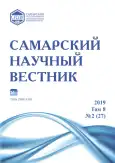Association of small mammal’s spatial distribution and vegetation cover structure (on the example of Pustyn closed wood, Nizhny Novgorod Region)
- Authors: Boryakova E.E.1
-
Affiliations:
- National Research Lobachevsky State University of Nizhny Novgorod
- Issue: Vol 8, No 2 (2019)
- Pages: 13-18
- Section: 03.02.00 – General Biology
- URL: https://journals.rcsi.science/2309-4370/article/view/34290
- DOI: https://doi.org/10.17816/snv201982102
- ID: 34290
Cite item
Full Text
Abstract
The following paper deals with the problem of spatial distribution of mouse-like rodents in connection with a vegetable cover character. Small mammals are studied as components of the whole system - biocenosis. The investigation was carried out during the summer of 2016 in the landscape protected area Pustyn located in the province of Nizhny Novgorod, Volga Upland. 6 sample plots were set up in different forest types. Micromammalia were trapped using a traditional method, over standard sample plots (20 × 20 m) in a random order. 226 animals were caught, they turned out to belong to 2 genera and 3 species: Cletrionomys glareolus Schreber, Apodemus flavicollis Melchior, Apodemus uralensis Pallas. Statistical analysis was fulfilled using Statistica 6.0 software suite. We used a nonparametric Spearman method for calculation of correlations. The Principal Component Analysis (PCA) was used for detection of groups of similar objects, to reduce the number of dimensions and for visualization of the results. Positive and negative correlation dependences between the number of micromammalia and abundance of separate species of plants are revealed. The PCA analysis has shown that there is a significant factor for spatial distribution of small mammals, which is positively connected with nitrogen-loving plants. Rodents generally prefer places where projective cover degree of vegetation makes about 60%. This value is possibly optimum for movement and holes digging; the shortage of food is possible when the covering indicators are smaller and the density of animal’s population is big. The bank vole shows ecological plasticity in the choice of habitats more than mice. Based on results of our research, it is possible to conclude that heterogeneity of a vegetation cover has an influence on spatial structure of micromammalia communities.
Full Text
##article.viewOnOriginalSite##About the authors
Elena Evgenievna Boryakova
National Research Lobachevsky State University of Nizhny Novgorod
Author for correspondence.
Email: boryakova@mail.ru
candidate of biological sciences, associate professor of Botany and Zoology Department
Russian Federation, Nizhni NovgorodReferences
- Новиков Г.А. Вопросы общей экологии и охраны природы. Л.: ЛГУ, 1979. 352 с.
- Калмыкова О.Г. О влиянии грызунов на растительный покров «Буртинской степи» (госзаповедник «Оренбургский») // Вестник Оренбургского государственного университета. 2007. № 4. С. 140-143.
- Pearson O.P. Characteristics of a mammalian fauna from forests in Patagonia, southern Argentina // Journal of Mammalogy. 1983. Vol. 64. P. 476-492.
- Murúa R., González L. Microhabitat selection in two chilean cricetid rodents // Oecologia. 1982. Vol. 52. P. 12-15.
- Pianalto F.S., Yool S.R. Sonoran Desert rodent abundance response to surface temperature derived from remote sensing // Journal of Arid Environments. 2017. Vol. 141. P. 76-85.
- Wegge P., Rolstad J. Cyclic small rodents in boreal forests and the effects of even-aged forest management: Patterns and predictions from a long-term study in southeastern Norway // Forest Ecology and Management. 2018. Vol. 422. P. 79-86. doi: 10.1016/j.foreco. 2018.04.011.
- Полуяхтов К.К. Лесорастительное районирование Горьковской области // Биологические основы повышения продуктивности и охраны лесных, луговых водных фитоценозов Горьковского Поволжья. Вып. 2. Горький: Изд-во Горьк. гос. ун-та им. Н.И. Лобачевского, 1974. С. 4-20.
- Баканина Ф.М., Лукина Е.В., Насонова Н.И. и др. Заповедные места Нижегородской области. Нижний Новгород: Волго-Вятское книжное. издательство, 1991. 191 с.
- Боряков И.В., Воротников В.П., Борякова Е.Е. Использование информационных технологий для организации фитоценариев и обработки геоботанических данных // Бот. журнал. 2005. Т. 90, № 1. С. 95-104.
- Пузанов И.И., Козлов В.И., Кипарисов Г.П. Позвоночные животные Нижегородской области. Изд. 3-е, перераб. и дополненное. Нижний Новгород: Изд-во Нижегород. ун-та, 2005. 544 с.
- Карасева Е.В., Телицына А.Ю. Методы изучения грызунов в полевых условиях. М.: Наука, 1996. 200 с.
- Громов И.М., Ербаева М.А. Млекопитающие фауны России и сопредельных стран. Зайцеобразные и грызуны. СПб.: Изд-во Зоологического института РАН, 1995. 522 с.
- Дмитриев А.И., Заморева Ж.А., Кривоногов Д.М. Млекопитающие Нижегородской области (прошлое и настоящее). Нижний Новгород: Изд-во НГПУ, 2008. 467 с.
- Растительные ресурсы России: Дикорастущие цветковые растения, их компонентный состав и биологическая активность. Т. 1. СПб.; М.: Товарищество научных изданий КМК, 2008. 421 с.
- Борякова Е.Е., Елизарова М.М., Тенин К.О. Пространственное распределение мелких млекопитающих в связи с характером растительного покрова в условиях города (на примере памятника природы «Дубрава Ботанического сада университета») // Изучение, сохранение и восстановление естественных ландшафтов: мат-лы VII всерос. с междунар. уч. конф. М.: Планета, 2017. С. 135-142.
- Ellenberg H., Weber H., Düll R., Wirth W., Werner W., Paulißen D. Zeigerwerte von Pflanzen in Mitteleuropa. 2nd ed. // Scripta Geobotanics. 1992. Vol. 18. P. 1-258.
- Zhong W., Wang G., Zhou Q. et al. Spatial niche partitioning of coexisting small mammals in sand dunes // Italian Journal of Zoology. 2016. Vol. 83, № 2. P. 248-254. doi: 10.1080/11250003.2016.1139636.
- Puan C. et al. Understanding of relationships between ground cover and rat abundances: An integrative approach for management of the oil palm agroecosystem [El. resource] // http://sciencedirect.com/science/article/ pii/S0261219411002031.
- Goodin D.G., Koch D.E., Owen R.D. et al. Land cover associated with hantavirus presence in Paraguay // Global Ecology and Biogeography. 2006. Vol. 15, Is. 5. P. 519-527.
- Root J.J., Calisher C.H., Beaty B.J. Relationships of deer mouse movement, vegetative structure, and prevalence of infection with Sin Nombre virus // Journal of Wildlife Diseases. 1999. Vol. 35 (2). P. 311-318.
- Palma R.E., Polop J.J., Owen R.D. et al. Ecology of rodent-associated hantaviruses in the southern cone of South America: Argentina, Chile, Paraguay, and Uruguay // Journal of Wildlife Diseases. 2012. Vol. 48, № 2. P. 267-281. doi: 10.7589/0090-3558-48.2.267.
Supplementary files











